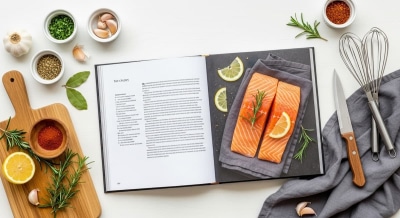How to Structure Better Web Pages for SEO – Recipe for Strategic Content
 Better websites are made up of great individual pages of good content. It really is just that simple. The best websites are built like a great cookbook. Each individual page, like a single recipe, must work on its own, serve a specific purpose, and be easy to follow. Those individual pages are usually laid out in simple formats to make it easy for the chef to understand, no matter which recipe they are preparing. When you approach web content this way, your site becomes clearer for your audience and performs better in search.
Better websites are made up of great individual pages of good content. It really is just that simple. The best websites are built like a great cookbook. Each individual page, like a single recipe, must work on its own, serve a specific purpose, and be easy to follow. Those individual pages are usually laid out in simple formats to make it easy for the chef to understand, no matter which recipe they are preparing. When you approach web content this way, your site becomes clearer for your audience and performs better in search.
This is our go-to recipe for building better-performing, audience-centered web pages.
Step 1: Know your Main Ingredient (your focus topic)
Every recipe starts with a core ingredient. You build a salad around arugula. A soup around lentils. A dessert around chocolate.
On your website, the “main ingredient” is the topic, the focus of that new page. And just like a good dish, one main ingredient (or keyword phrase) is enough. Don’t dilute the dish by trying to do too much.
Choose one clear topic per page. Be specific. “Salmon” is a start. “Wild Alaskan Salmon” is better. “Best Sides for Wild Alaskan Salmon” might be exactly what your audience is hungry for.
✅ Before you write, identify your audience and their search intent.
✅ Use that to define your focus phrase or topic, what the page is really about.
Step 2: Prep Your Layout (before you write a word)
A solid recipe has structure, ingredients, instructions, tips, FAQs. Good web pages do too.
Think through:
- What do I want someone to learn here?
- How will they scan or digest the content?
- What action should they take afterward?
- What are the common questions asked about your main ingredient?
Having a rough outline (or even just a few section headers) can keep your writing tight and on target.
Step 3: Write for Both People and Search Engines (and A.I.)
Your page needs to work for real humans and search engines. That doesn’t mean stuffing keywords. It means being intentional with structure and semantics.
Include:
- A single Heading 1 (H1) at the top with your focus phrase.
- Meta description that clearly (and invitingly) summarizes what your reader can expect.
- Subheadings (H2s, H3s) that guide readers through your content.
- Naturally written content that connects to your focus topic, not just repeats it.
Think of it like seasoning, subtle, consistent, and purposeful.
Step 4: Use Images with Intention
Photos make pages more compelling, just like in a cookbook.
Don’t just toss in a stock image and call it a day. Use visuals that:
- Support the message or demonstrate a concept
- Are resized properly to reduce page load times
- Have descriptive, helpful alt text (not keyword-stuffed)
- Updated file name to be descriptive also
If your page is about “Wild Alaskan Salmon,” your image might be:
“Grilled wild Alaskan salmon filet on cedar plank with lemon wedges”
That helps search engines and accessibility.
Step 5: Write Like You’re Teaching (not selling)
This is where the real flavor lives. Good content teaches, guides, and helps.
Great web page content:
- Stays focused on one topic
- Speaks in a clear, conversational tone
- Anticipates what your audience might be confused by or curious about
- Uses internal links to related content (like ingredients that work well together)
The best content reads like a recipe written by a friend: structured, approachable, and easy to scan and follow.
Common Mistakes to Avoid
- Targeting the same topic across multiple pages (confusing for Google and users)
- Writing without knowing your focus keyword phrase
- Overloading a page with images or oversized files
- Using vague image names or empty alt tags (did you name your file correctly too?)
- Cramming in keywords unnaturally
- Forgetting what a first-time visitor doesn’t already know
Best Practices Checklist
✅ Choose one clear focus topic
✅ Use that topic in the page title and H1
✅ Write a compelling meta description (150–160 characters)
✅ Add 1–2 relevant, properly sized images
✅ Use descriptive alt text (not stuffed)
✅ Structure content with scannable headers
✅ Link to related internal pages
✅ Write naturally and with clarity
Final Thought
Each page you create is a chance to build trust, teach something valuable, and invite the right audience closer. The better your “recipes,” the stronger your whole site becomes.
Search engines notice structure. Humans notice usefulness. When you combine both, you don’t just get a better page; you get better outcomes.